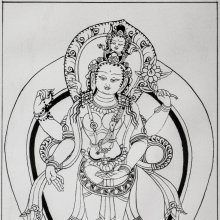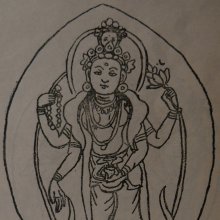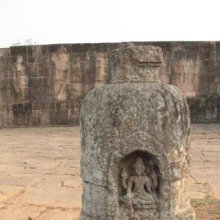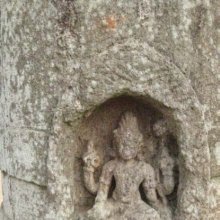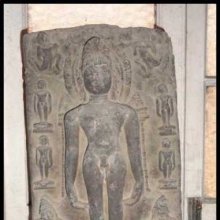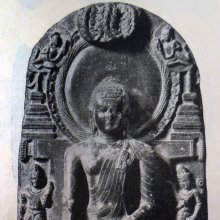Jatamukuta, Jaṭāmukuṭa, Jata-mukuta: 7 definitions
Introduction:
Jatamukuta means something in Buddhism, Pali, Hinduism, Sanskrit. If you want to know the exact meaning, history, etymology or English translation of this term then check out the descriptions on this page. Add your comment or reference to a book if you want to contribute to this summary article.
Images (photo gallery)
(+6 more images available)
In Hinduism
Shilpashastra (iconography)
Source: Google Books: The Book of Hindu Imagery: Gods, Manifestations and Their MeaningA crown of artfully plaited braids, which is reminiscent of the shape of the kiritamukuta, and is often just as lavishly decorated. Jatamukuta is the crown of an ascetic. It is worn particularly by Shiva (though in fact not when he is depicted as an ascetic), with a sickle or skull as the characteristic ornament, and by Brahma, decorated with jewels.
Source: Google Books: Elements of Hindu iconographyThe Jaṭāmukuṭa (जटामुकुट) is, as the name indicates, made up of twists of matted hair done into the form of a tall cap. The Uttara-kāmikāgama gives the following rather long and somewhat unitelligible description of the uṣṇīṣa in which the Jaṭāmukuṭa is included.
“The Jaṭāmukuṭa is in fact as described below: five jaṭās or braids of matted hair are taken and tied into a know three inches in height ny coiling them into one or three loops, the remaining braids being bound and taken through to be left hanging on both sides”
This Jatāmukuṭa is prescribed for Brahmā and Rudra among the gods, and for Manonmaṇi among the goddesses.

Shilpashastra (शिल्पशास्त्र, śilpaśāstra) represents the ancient Indian science (shastra) of creative arts (shilpa) such as sculpture, iconography and painting. Closely related to Vastushastra (architecture), they often share the same literature.
Natyashastra (theatrics and dramaturgy)
Source: Wisdom Library: Nāṭya-śāstraJaṭāmukuṭa (जटामुकुट) refers to a “crown of matted hair”, which is the prescribed appearance for Munis, according to Nāṭyaśāstra chapter 23. It is composed of the words kuñcita (curved) and mūrdhaja (hair of the head). Providing masks is a component of nepathya (costumes and make-up) and is to be done in accordance with the science of āhāryābhinaya (extraneous representation).

Natyashastra (नाट्यशास्त्र, nāṭyaśāstra) refers to both the ancient Indian tradition (shastra) of performing arts, (natya—theatrics, drama, dance, music), as well as the name of a Sanskrit work dealing with these subjects. It also teaches the rules for composing Dramatic plays (nataka), construction and performance of Theater, and Poetic works (kavya).
Shaktism (Shakta philosophy)
Source: Google Books: ManthanabhairavatantramJaṭāmukuṭa (जटामुकुट) (Cf. Jaṭāmakuṭa) refers to “(one adorned with) matted hair and crown” and is used to describe Ardhanarīśvara, according to the second recension of the Yogakhaṇḍa of the Manthānabhairavatantra, a vast sprawling work that belongs to a corpus of Tantric texts concerned with the worship of the goddess Kubjikā.—Accordingly, as Bhadrakālī said to Śrīkaṇṭha: “[...] O Śaṃkara, you also displayed this, one of your forms. Thus, O lord Śaṃkara, I wish to see you, Śaṃkara. O Lord, you have appeared (before) in this way by the power of supreme knowledge. (You are) he, the Siddha who has been pierced (by the power of the Command) and, made of universal bliss, is accompanied by Yogeśvarī. He is Śaṃkara’s lord; supreme, he has five faces, three eyes, holds a spear and, adorned with matted hair and crown [i.e., jaṭāmukuṭa-maṇḍita], (his) divine body is covered with ashes. He is the pervasive lord Ardhanarīśvara”.

Shakta (शाक्त, śākta) or Shaktism (śāktism) represents a tradition of Hinduism where the Goddess (Devi) is revered and worshipped. Shakta literature includes a range of scriptures, including various Agamas and Tantras, although its roots may be traced back to the Vedas.
Purana and Itihasa (epic history)
Source: archive.org: Shiva Purana - English TranslationJaṭāmukuṭa (जटामुकुट) refers to “(wearing) matted hair and crowns”, according to the Śivapurāṇa 2.3.40 (“The Marriage Procession of Śiva”).—Accordingly, as Brahmā narrated to Nārada: “[...] These and other leaders of Gaṇas of great strength and multitudinous in number joined the procession with joy and enthusiasm. They had a thousand hands. They wore matted hair and crowns (jaṭāmukuṭa-dhārin). They were bedecked with streaks of the moon. They had three eyes and blue necks (like lord Śiva). All of them wore garlands of Rudrākṣa beads. They had the holy ashes smeared over the body. They had the ornaments of necklaces, earrings, bracelets, crowns etc. [...]”.

The Purana (पुराण, purāṇas) refers to Sanskrit literature preserving ancient India’s vast cultural history, including historical legends, religious ceremonies, various arts and sciences. The eighteen mahapuranas total over 400,000 shlokas (metrical couplets) and date to at least several centuries BCE.
In Buddhism
Tibetan Buddhism (Vajrayana or tantric Buddhism)
Source: archive.org: The Indian Buddhist IconographyJaṭāmukuṭa (जटामुकुट) or Jaṭāmukuṭalokeśvara refers to number 12 of the 108 forms of Avalokiteśvara found in the Machhandar Vahal (Kathmanu, Nepal). [Machhandar or Machandar is another name for for Matsyendra.].
Accordingly,—
“Jaṭāmukuṭa is four-armed and one-faced, the head on the top representing the head of Amitābha. The two right hands show the rosary and the Varada pose, while the two left hold the lotus and the water-pot. He is represented in a standing attitude”.
The names of the 108 deities [viz., Jaṭāmukuṭa] possbily originate from a Tantra included in the Kagyur which is named “the 108 names of Avalokiteshvara”, however it is not yet certain that this is the source for the Nepali descriptions. Tibetan Buddhism includes schools such as Nyingma, Kadampa, Kagyu and Gelug. Their primary canon of literature is divided in two broad categories: The Kangyur, which consists of Buddha’s words, and the Tengyur, which includes commentaries from various sources. Esotericism and tantra techniques (vajrayāna) are collected indepently.
Languages of India and abroad
Kannada-English dictionary
Source: Alar: Kannada-English corpusJaṭāmukuṭa (ಜಟಾಮುಕುಟ):—[noun] a kind of headwear, crown or depiction (in painting, sculpture, etc.) with a wider base and tapering at the top, resembling a knot of hair.
Kannada is a Dravidian language (as opposed to the Indo-European language family) mainly spoken in the southwestern region of India.
See also (Relevant definitions)
Partial matches: Jata, Mukuta.
Starts with: Jatamukutadharin, Jatamukutalokeshvara.
Full-text (+6): Jata, Mauli, Mandita, Jatamukutalokeshvara, Brahma, Mukuta, Jatamakuta, Pretasantarpita, Nirmanadeva, Linga, Pitaprajnaparamita, Ganapati, Vajrasana, Simhanada, Padmanartteshvara, Raktalokeshvara, Shuklakurukulla, Vajrananga, Lokanatha, Dashabhujasita.
Relevant text
Search found 10 books and stories containing Jatamukuta, Jaṭāmukuṭa, Jata-mukuta, Jaṭā-mukuṭa; (plurals include: Jatamukutas, Jaṭāmukuṭas, mukutas, mukuṭas). You can also click to the full overview containing English textual excerpts. Below are direct links for the most relevant articles:
Jainism in Odisha (Orissa) (by Ashis Ranjan Sahoo)
Jaina Sculptures of Odisha in Foreign Museums < [Chapter 3: Survey of Jaina Antiquities in Odisha]
Santinatha image at Paramanandapur < [Chapter 3: Survey of Jaina Antiquities in Odisha]
Jaina Antiquities in Choudwar (Cuttack) < [Chapter 3: Survey of Jaina Antiquities in Odisha]
Garga Samhita (English) (by Danavir Goswami)
Verse 1.4.48 < [Chapter 4 - Description of Questions About the Lord’s Appearance]
Sripura (Archaeological Survey) (by Bikash Chandra Pradhan)
Scultures of Ratnapani < [Chapter 3 - Sculptural Programme]
Scultures of Avalokitesvara < [Chapter 3 - Sculptural Programme]
Scultures of Ratnasamabhava < [Chapter 3 - Sculptural Programme]
Jain Remains of Ancient Bengal (by Shubha Majumder)
Pañca-tīrthika type of Ṛṣabhanātha sculptures < [Chapter 6 - Iconographic Study of Jaina Sculptural Remains]
Single depiction of Ṛṣabhanātha sculptures < [Chapter 6 - Iconographic Study of Jaina Sculptural Remains]
Jain Aṣṭāpadatīrtha Sculptures < [Chapter 6 - Iconographic Study of Jaina Sculptural Remains]
The Indian Buddhist Iconography (by Benoytosh Bhattachacharyya)
108 forms of Avalokiteśvara (12): Jaṭāmukuṭa Lokeśvara
Stupas in Orissa (Study) (by Meenakshi Chauley)
Drum slabs at at Ratnagiri < [Chapter 4]
Minor Votive Stupas at Ratnagiri < [Chapter 4]
Minor Structural Stupas at Udayagiri (Southern Zone) < [Chapter 4]
Related products
